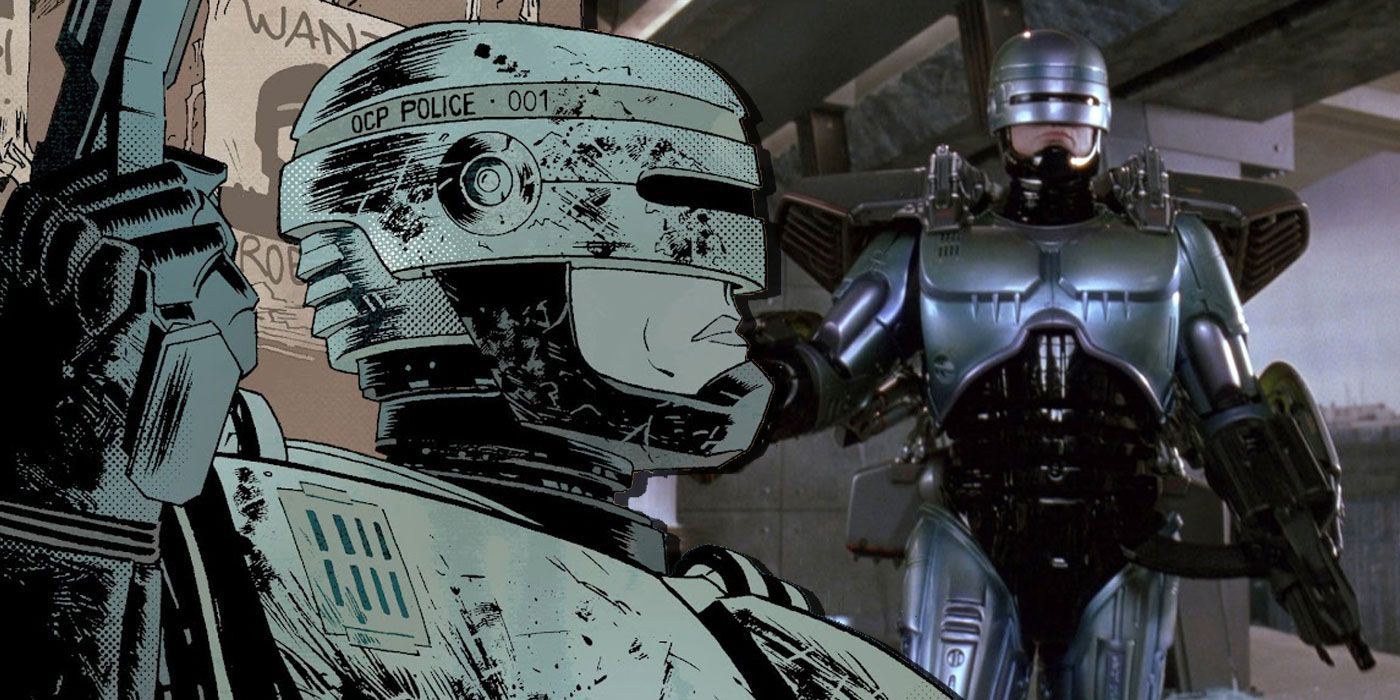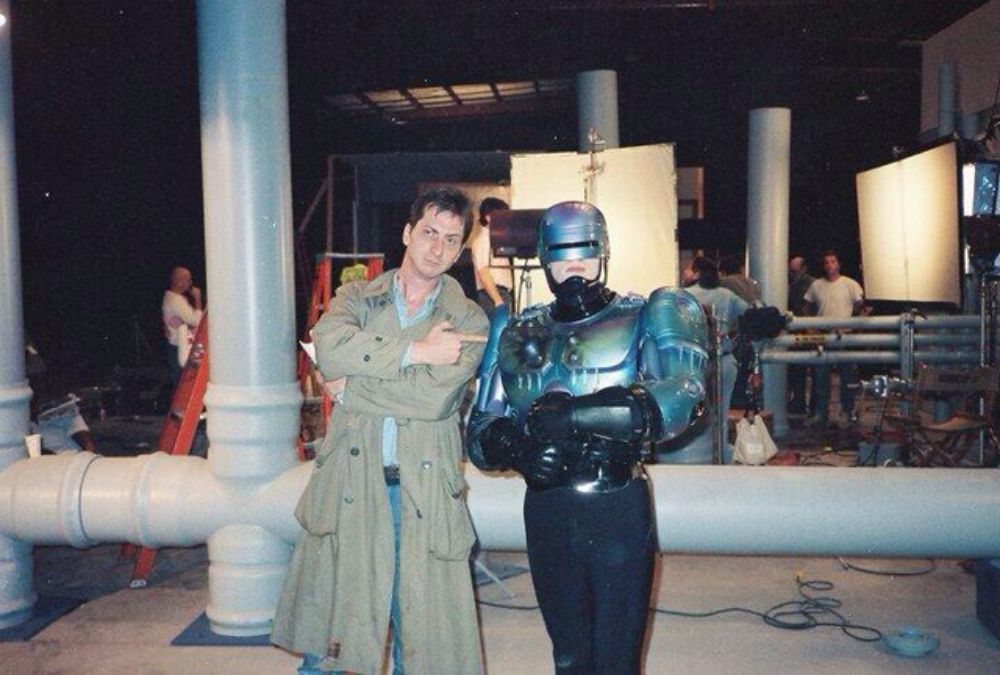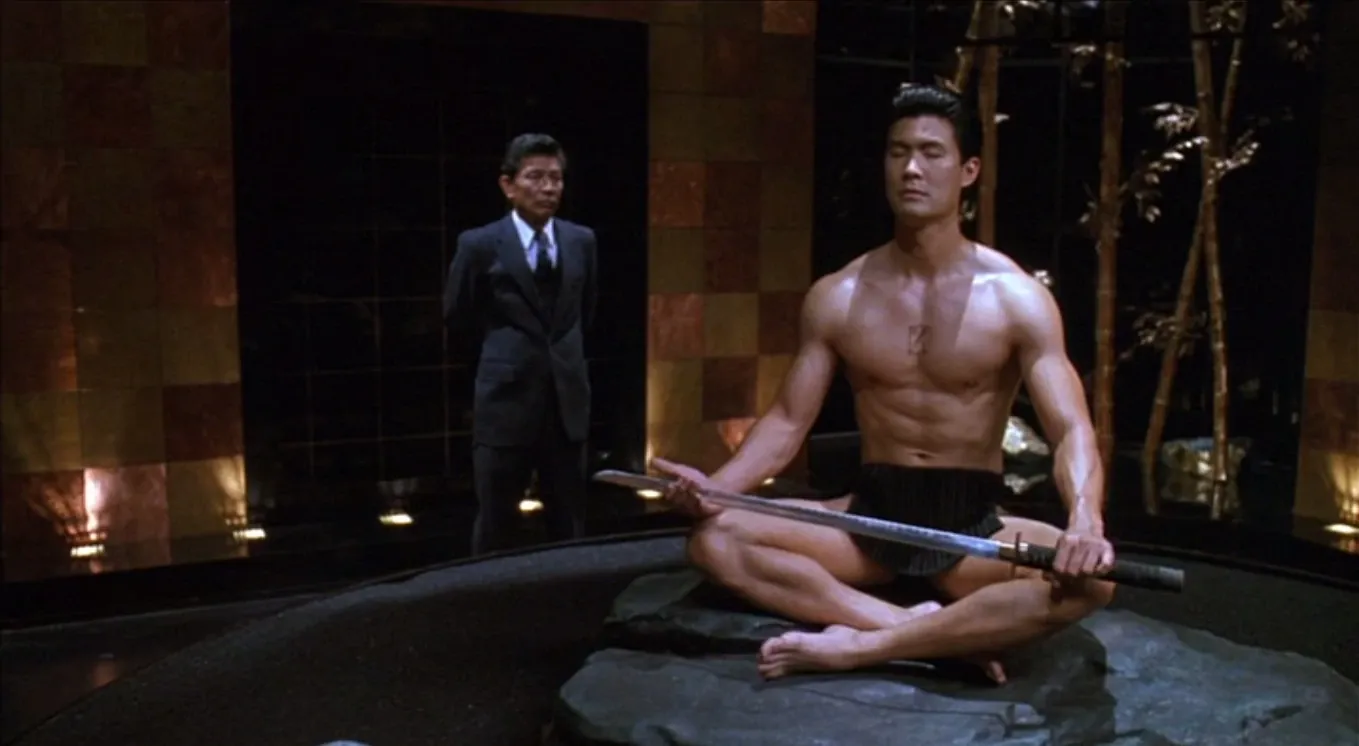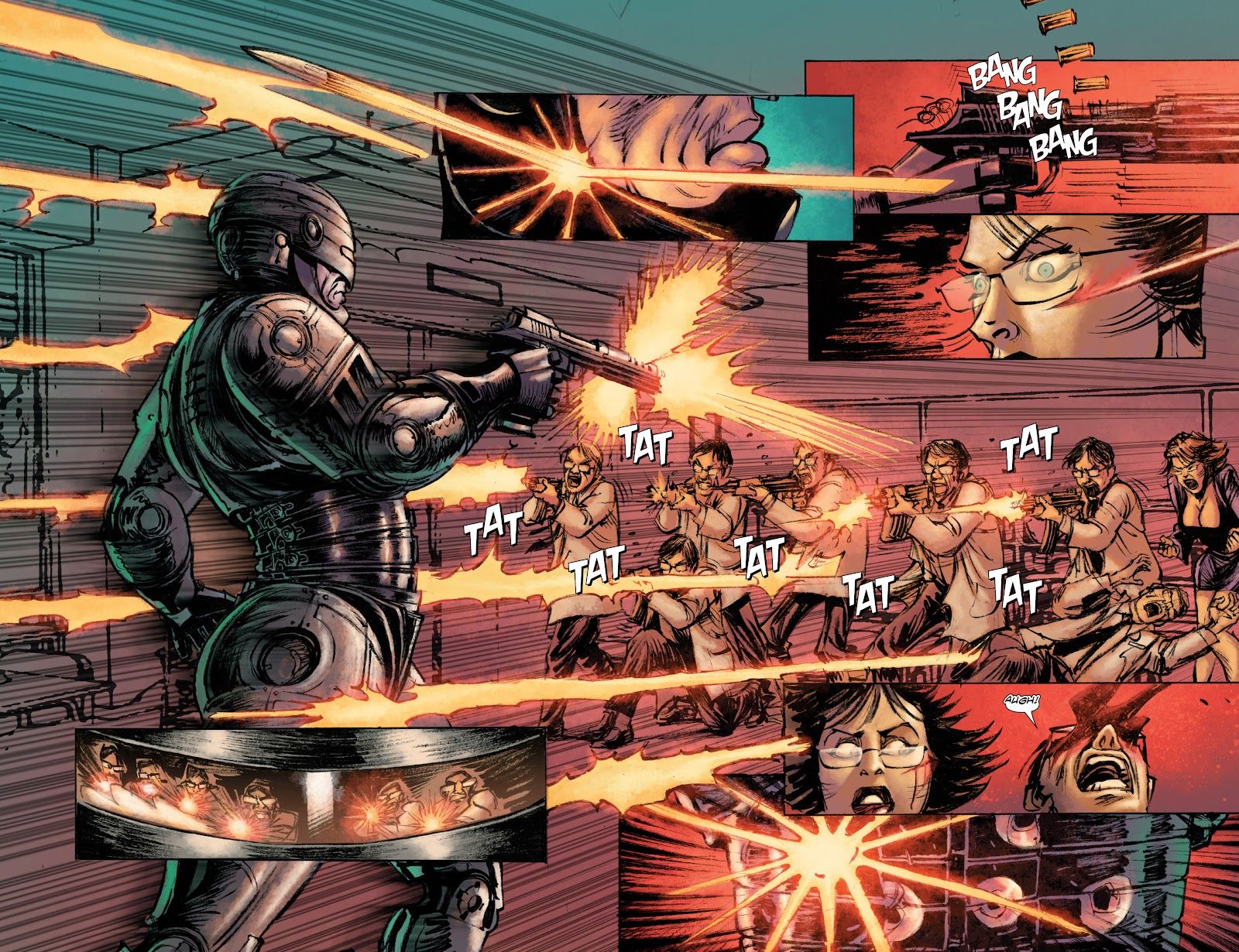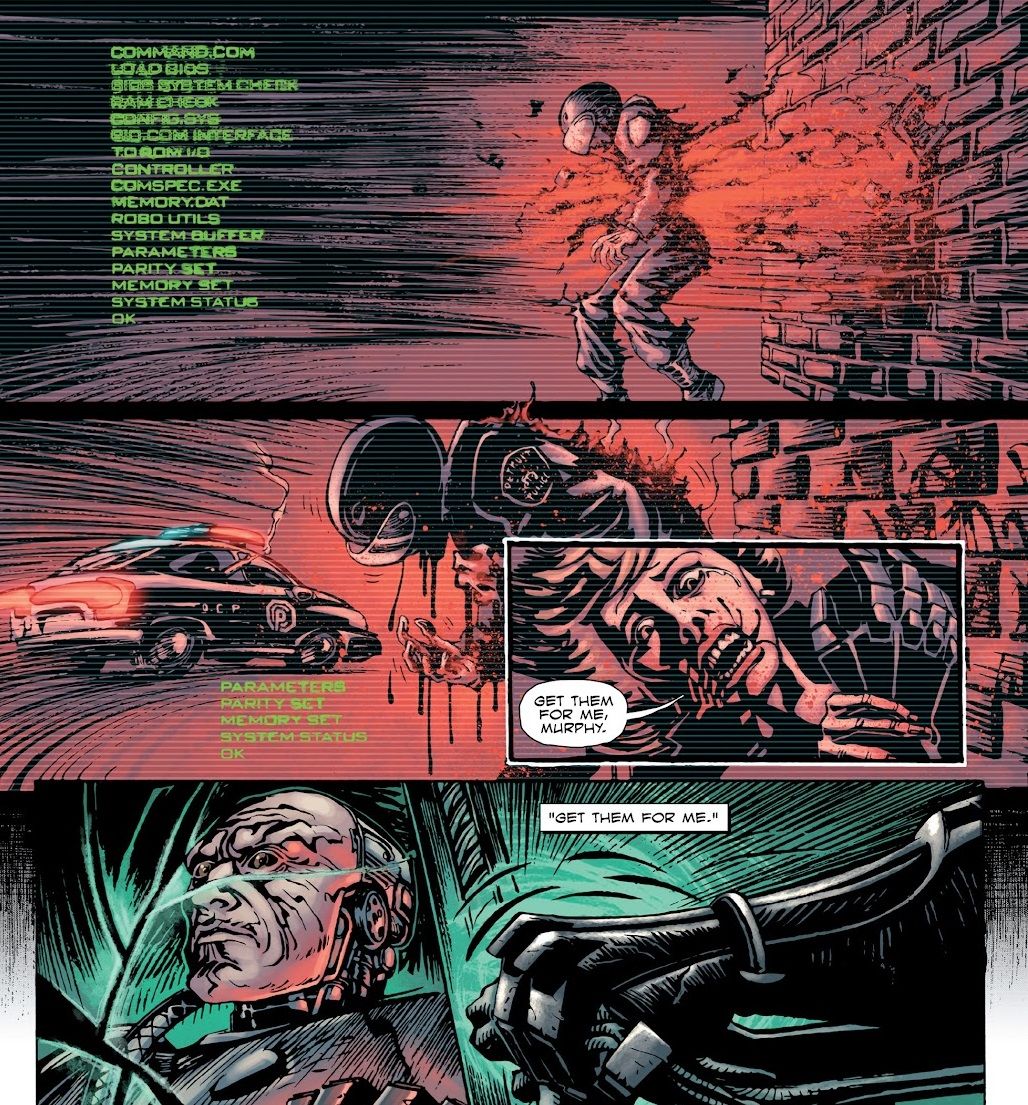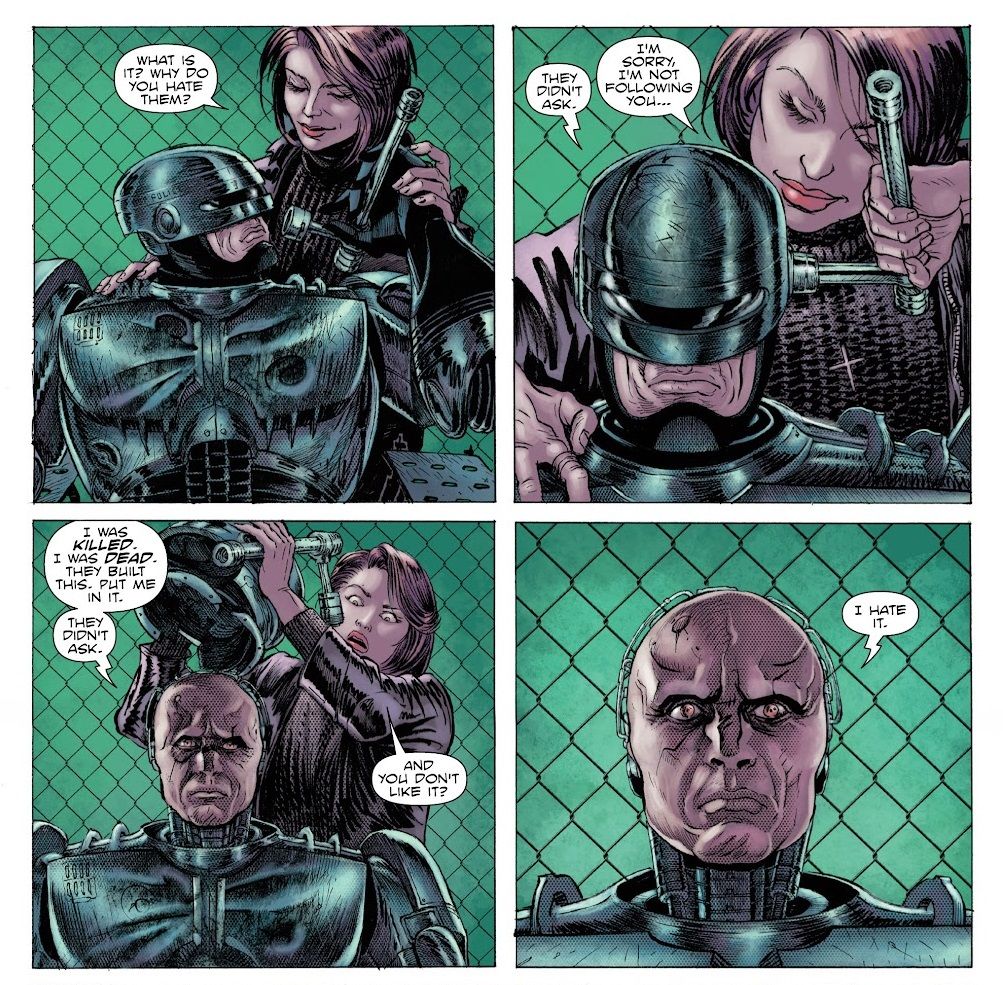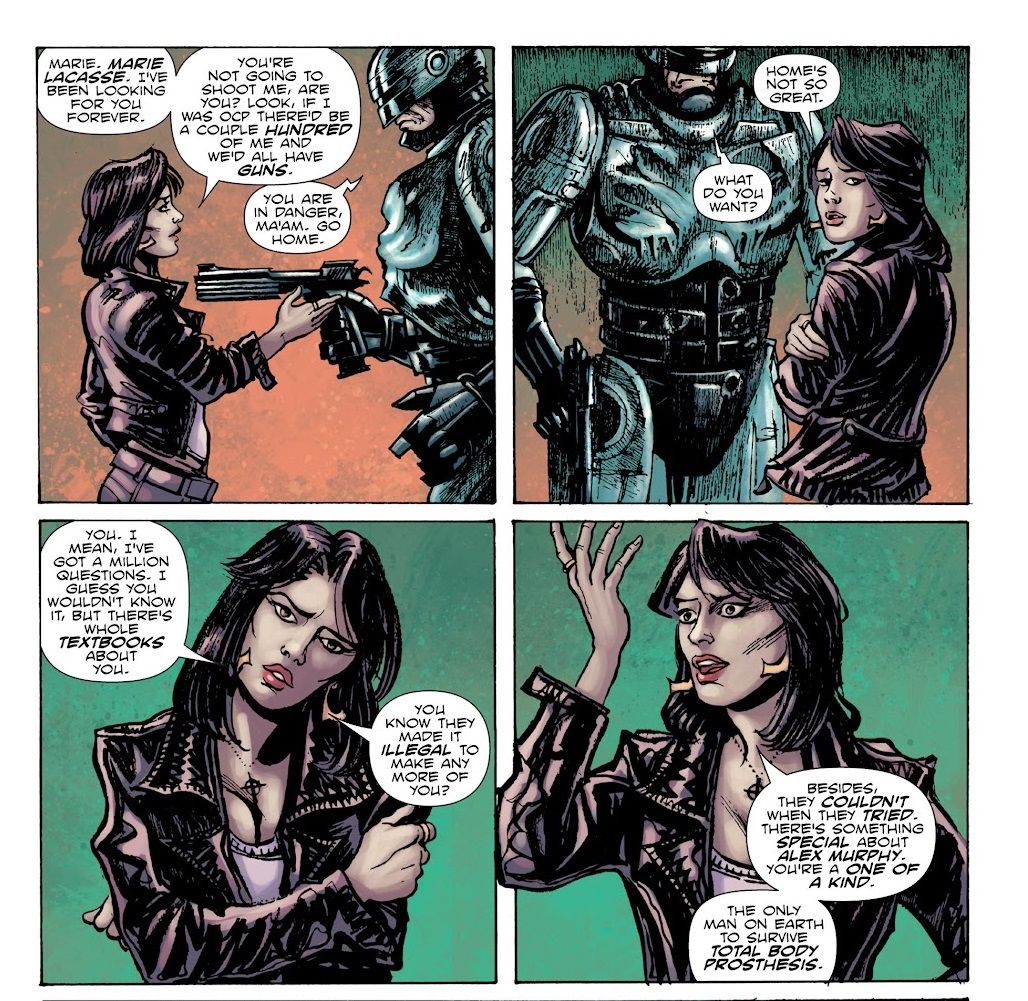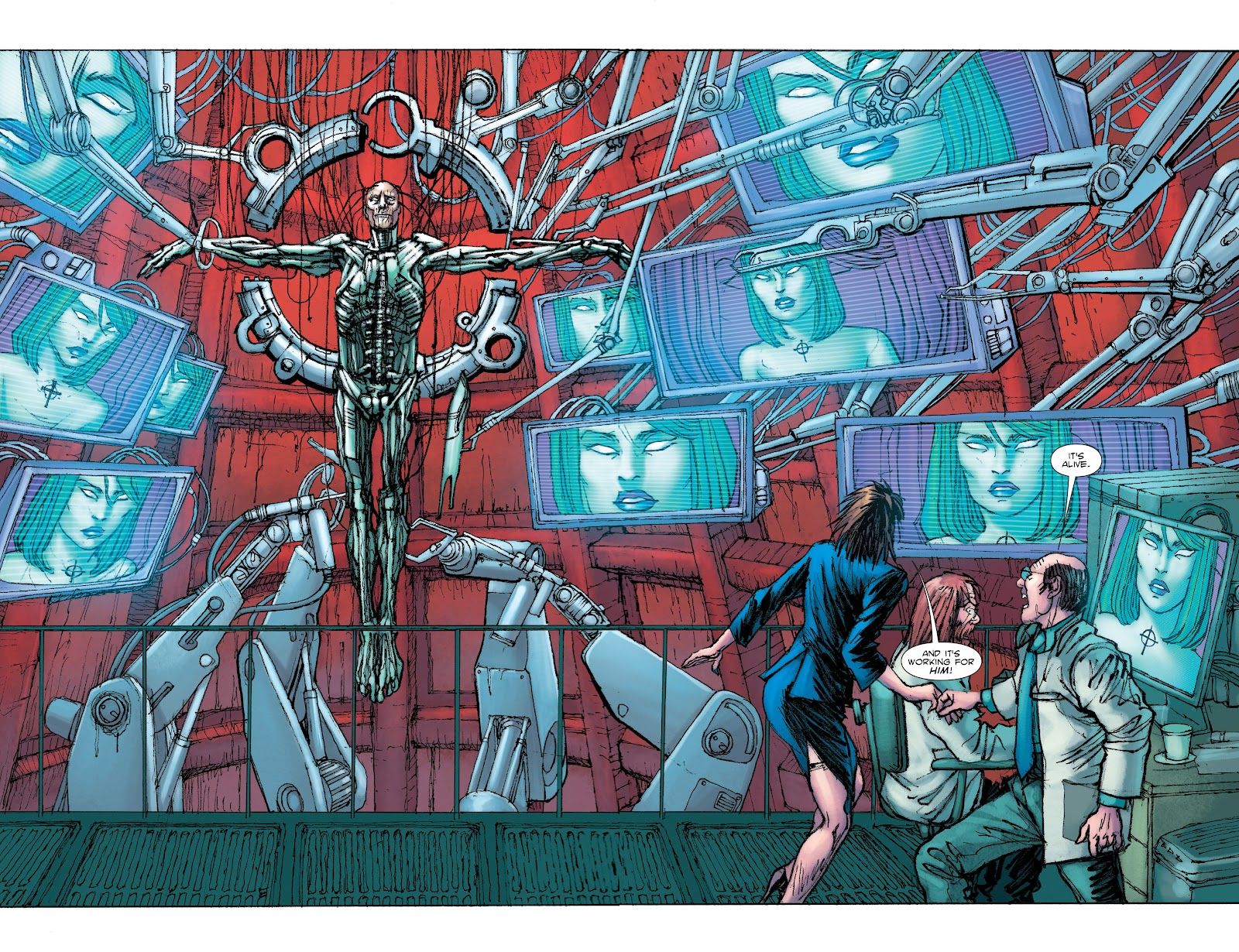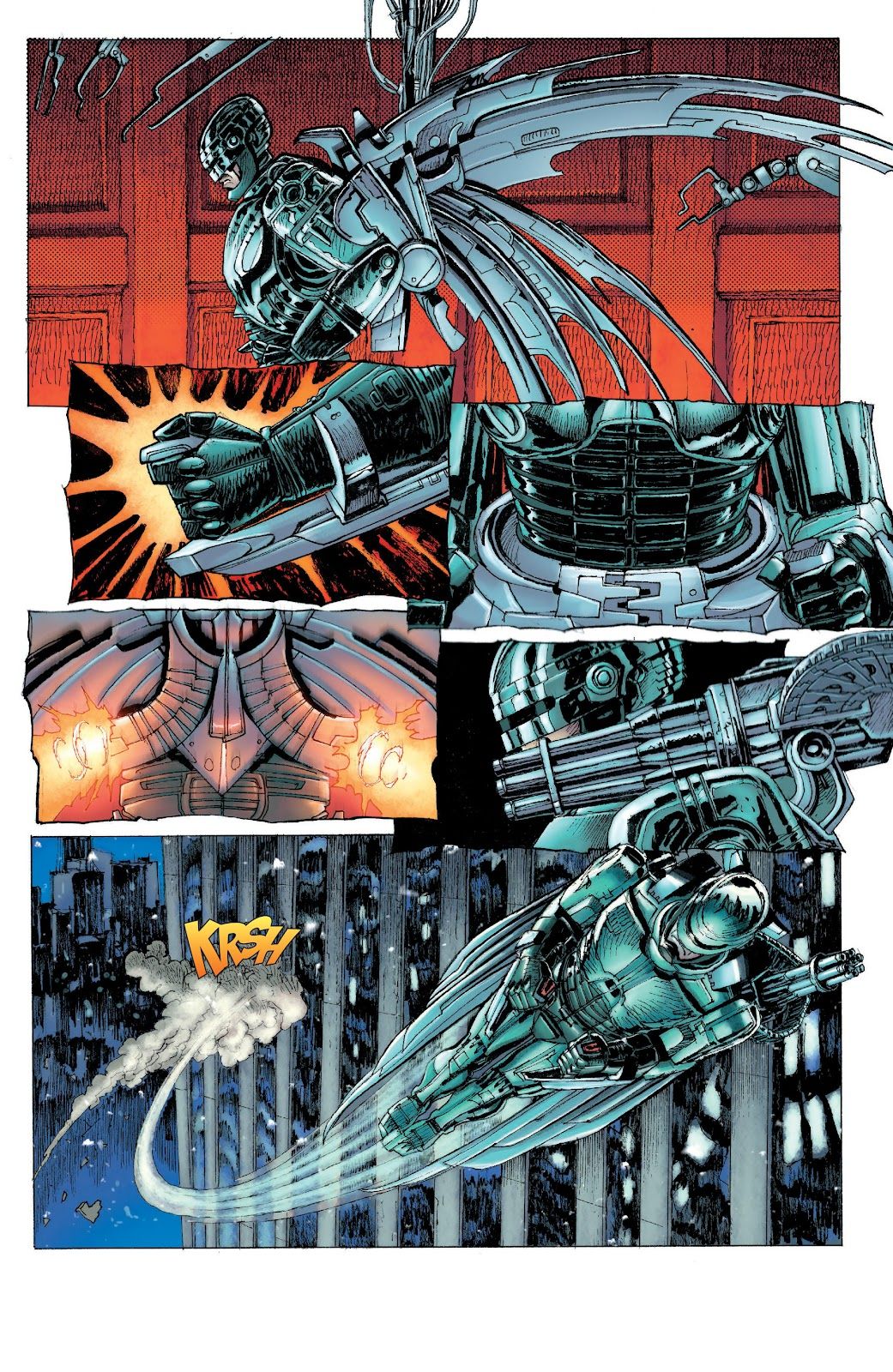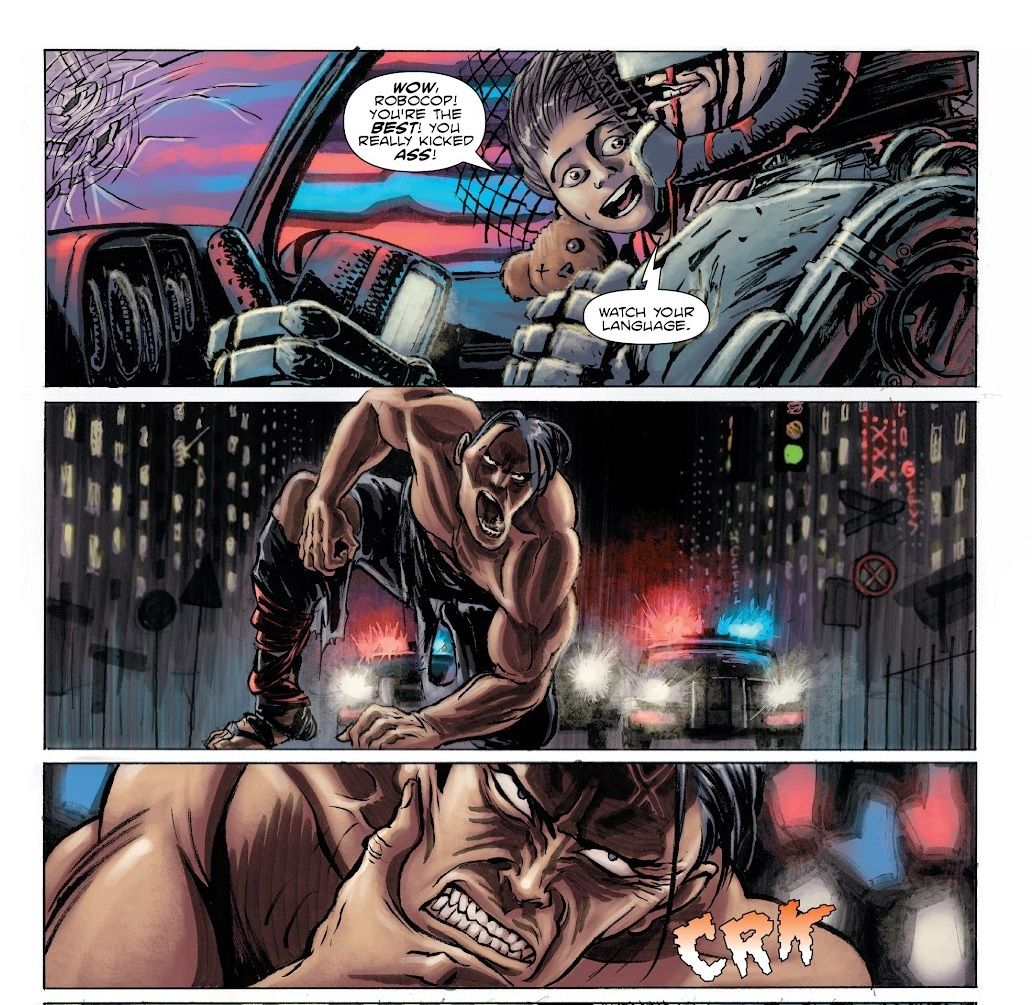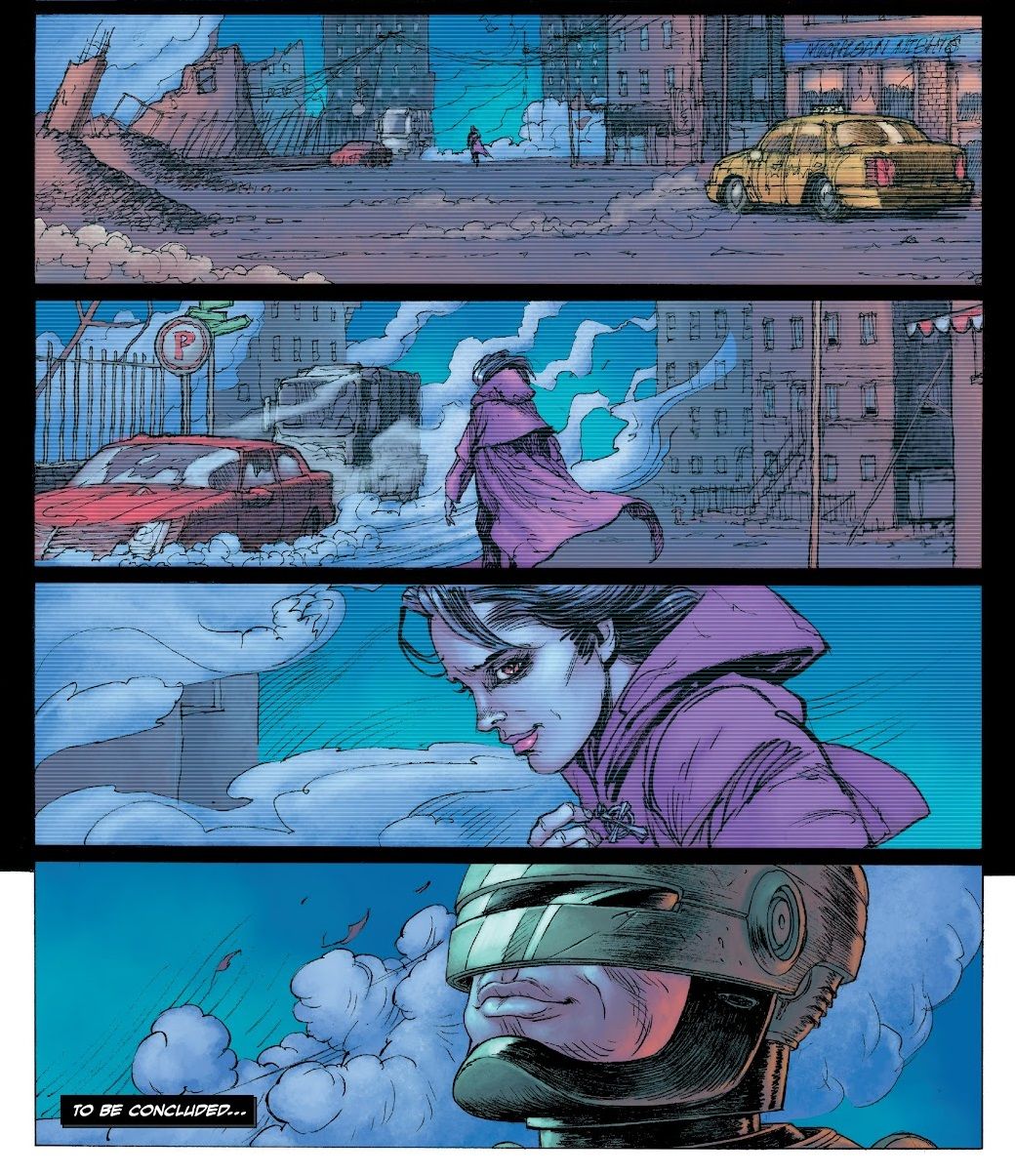Welcome to the 23rd installment of Page One Rewrite, where I examine genre screenplays that just couldn't make it. This week, Frank Miller tries again with RoboCop, and we have a convenient graphic novel read-along. And if you have future suggestions, please let me know on Twitter.
As covered previously in this series, the writers of 1987's RoboCop film were comics fans -- which might help to explain why the movie plays out as a demented, adults-only blend of Jack Kirby and 2000 AD -- at a time when admitting such a thing was the furthest thing from cool.
When asked by the movie studio to name potential scribes for spinoff RoboCop projects, co-creator Ed Neumeier threw out two of the biggest names in '80s comics: Alan Moore and Frank Miller. Moore declined, while Miller was intrigued.
Miller would end up with co-writing credits on both RoboCop 2 and 3 but would consistently dismiss the final films. His most famous quote regarding the RoboCop experience comes from a 2005 interview with G4: "I learned the same lesson: Don't be the writer. The director's got the power. The screenplay is a fire hydrant, and there's a row of dogs around the block waiting for it."
Given Miller's status in the industry, however, many were curious to read his original plans for these films, both released as critical disappointments. In 2003, Avatar adapted his RoboCop 2 as the comic book miniseries Frank Miller's RoboCop, with scripter Steven Grant and artist Juan José Ryp. In 2013, Boom! followed suit with Miller's early RoboCop 3 draft, released as RoboCop: Last Stand.
At Last…PG-13 RoboCop
The official RoboCop 3 from 1993 is the original film series' final release, derided for its generic plot, reduced budget, and kid-friendly tone. Original star Peter Weller was also gone, replaced by the still relatively unknown Robert Burke. The movie's release was delayed a year thanks to Orion Pictures' bankruptcy. Orion also mandated a PG-13 rating, hoping to appeal to the kids who loved the concept, toys, and video games…but weren't allowed to watch the actual films.
RoboCop 3's plot has evil conglomerate OCP continuing the dream of its deceased CEO, "The Old Man," in building the new Delta City over the remains of Detroit's poorer neighborhoods.
Their new corporate partner, Japan's Kanemitsu Corporation, sends a robotic enforcer named Otomo to speed things along. Meanwhile, the Detroit Police are replaced by OCP-backed "Rehab" security forces, thugs with no qualms about evicting innocent civilians.
The Rehabs are led by Paul McDaggett, who kills RoboCop's partner Anne Lewis after she sticks up for Detroit's "squatters." RoboCop then joins a civilian rebellion, which includes community advocate Bertha Washington, child computer prodigy Nikko Halloran, a reprogrammed ED-209, and Dr. Marie Lazarus, one of the scientists responsible for creating RoboCop. With their help, RoboCop defeats both McDaggett and Otomo, and the Kanemitsu Corporation's CEO even shows up at the end to shake RoboCop's hand and affirm all of OCP's dirty dealings are now done. There's also a sequence of RoboCop soaring above Detroit in a jetpack, something the studio must've adored, given its prominence in all publicity for both the film and accompanying merchandise.
Free, Unfettered Frank Miller
So, how much of this mom-friendly nonsense with evil developers, kid geniuses, and jetpacks can be found in Miller's original script? Surprisingly, quite a lot of it. Our access to Miller's early draft comes courtesy of the RoboCop: Last Stand comics adaptation from scripter Steven Grant and artist Korkut Öztekin. Like Avatar before it, Boom! sought to assure readers they were getting free, unfettered Frank Miller. According to assistant editor Alex Galer: "While Steven Grant has broken the screenplay into panel by panel scripts, no word or scene was altered from the original screenplay. You have before you the exact adaptation of Frank Miller's script."
What isn't in Last Stand is also notable. Paul McDaggett doesn't appear, and Anne Lewis' death occurs in a quick flashback sequence. The new OCP replacement cops are never referred to as "Rehabs" (even though the term originates with Miller's earliest RoboCop 2 script). There's no pat ending with Mr. Kanemitsu showing up to make things right, and the generically pleasant Dr. Lazarus is also absent, replaced with a far more intriguing character.
Another noteworthy element is the inclusion of Dr. Juliette Faxx from RoboCop 2, reintroduced as recently paroled and still ascending OCP's corporate ladder. In Miller's initial RoboCop 2 screenplay, the villain's Margaret Love, an even nastier avatar of political correctness run amuck.
It's unclear at which stage Miller wrote this draft for RoboCop 3…is it a sequel to the earlier script Avatar adapted as Frank Miller's RoboCop, or a follow-up to the theatrically released RoboCop 2 film, which had little in common with Frank Miller's RoboCop? It's also possible that this script did name the villainess Dr. Margaret Love, but Boom! chose to go with Faxx's name, as Miller later recycled Love as the villain in 1994's Spawn/Batman, potentially creating legal headaches.
Although the screenplay does have some superficial similarities with the completed film, it's clear from this adaptation that it was not intended as a PG-13 release. While not as abrasive or ugly as Frank Miller's RoboCop, there's still no shortage of adult language and ultra-violence. And Miller fans will recognize his ongoing exploration of religious themes, nods to comics pros like Stephen Bissette, Hildy Mesnick, Lynn Varley, Will Eisner, and of course, Akira creator Katsuhiro Otomo, and references to Miller's previous works -- it's not hard to see Ronin in Otomo and Martha Washington in Bertha.
RoboCop In Love
According to the Last Stand press releases, Miller wrote this script as the final entry in RoboCop's story, what he intended as a true finale for what was (at one point) a trilogy of films. In that context, some of the choices are defensible. This also explains why RoboCop joining the anti-OCP resistance is certainly an aspect of this script but doesn't necessarily dominate the plot as it does RoboCop 3. If the film stayed true to Miller's vision, RoboCop 3 would've been what everyone wants in a RoboCop flick -- a techno-futurist love story.
A key figure in Miller's draft is Dr. Marie Lacasse, who tracks down the outlaw RoboCop and uses her technical skills to repair his damaged body. Marie's also clear that she's arrived solely to aid RoboCop, who she's obsessively studied from afar. She's openly disdainful of the lower-class tenants RoboCop is defending, which is potentially a nice conflict that unfortunately doesn't go anywhere.
It's clear Dr. Marie Lacassie became Dr. Marie Lazarus in the finished film, and most of her hacking abilities were given to the kid sidekick, Nikko. A version of Nikko is in this early draft, but she's presented as an ordinary girl orphaned by OCP…who turns out to be a robotic OCP spy who penetrates the rebels' base.
As the climax looms, Otomo locates the rebels, kills Marie, and takes an inert RoboCop back to OCP. When OCP dismantles RoboCop, this opens a dormant computer virus Marie had planted inside RoboCop's programming.
Marie reappears as an ethereal computer icon, a floating godlike figure, overrunning OCP's systems. As RoboCop's body hangs from a techno-cross in an OCP lab, the omnipotent Marie plots his resurrection.
The new, improved body for her adored RoboCop brings us the rather infamous jetpack, though it looks much cooler in the Last Stand adaptation. Marie, played as both a lover and a savior, also arms RoboCop with machine guns, claws, rockets, and metallic "angel" wings.
Although Marie has prepped RoboCop for war, she gives him the option of abandoning his campaign against OCP, instead offering him endless love if he joins with the new robotic body she's constructing for herself with OCP's resources. It's a choice between peace and war, a conflict that evokes Alex Murphy's past as a devout Catholic and family man, an aspect of RoboCop sometimes glossed over in the films but essential to Miller's view of the character.
The Death of OCP
Another aspect of RoboCop 3 that didn't exactly blow viewers away was Otomo, the ninja robot. While he does come across as generic and not overly threatening in the film (not to mention a concept already dated by the early '90s), he is far more memorable in Miller's draft.
There's some disturbing body horror material with Otomo that wouldn't play in a PG-13 film and a climactic battle that pits RoboCop against dozens of Otomo robots…while the movie cheaped out and only provided two. Otomo's also a player in the script's opposing love story. Dr. Faxx becomes enchanted by Otomo's power and masculinity, seduces him, and has him join her in a coup of OCP leadership. Miller even has the duo murder The Old Man in one scene shortly before they fall into bed together.
With Marie's aid, the Otomo army is defeated, going up in a literal mushroom cloud that would surely destroy the neighborhoods RoboCop's defending, but no one seems to mind. With OCP thoroughly embarrassed in Kanemitsu's eyes, the rebels believe they now have their freedom. RoboCop eyes the robotic Marie emerging in the distance, and we're left with the hope he might join her as a post-human couple, custom-built for this modern age.
Walking Stiffly into the Sunset
RoboCop 3 is rightfully viewed as a cynical exploitation of the brand, Orion's last-gasp attempt to repackage the franchise for a broader audience that can't compete with the first film. Miller's earliest draft is far from this, offering an intriguing vision of how RoboCop's story could end and finding provocative parallels between Alex Murphy's death and resurrection and core Christian doctrine. But would it have pleased those disappointed in RoboCop 3?
The love story would likely be a difficult sell, especially if it stayed as thin as dramatized by Last Stand. Marie is meant to symbolize all these powerful ideas, but she's presented as little more than a stalker with unique hacking gifts. Affirming that RoboCop has made peace with the loss of his wife and family and he sees something worth pursuing in Marie would also go a long way in selling this.
Another dicey element of Miller's draft is the lack of subversive humor seen in the previous films. Miller's initial RoboCop 2 screenplay leaned heavily in this direction, but this time he doesn't seem as interested in the deranged futuristic commercials or parody newscasts (or perhaps he was directed to knock this nonsense off). Most of the humor comes at the expense of RoboCop's assorted body parts falling off or the foul-mouthed ED-209 robot.
Ultimately, Last Stand is an uneven reading experience, but some thought-provoking concepts exist. As a "final" RoboCop story, and not simply more product churned out, an extended ad for the merchandise and upcoming syndicated television series, it has potential. And, as unbelievable as this might sound, there is a chance that jetpack didn't have to be so embarrassing.

